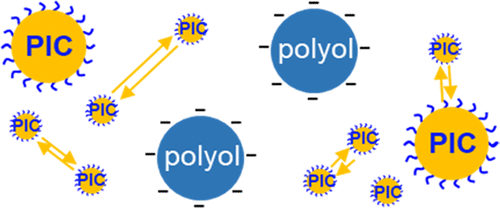当前位置:
X-MOL 学术
›
Macromolecules
›
论文详情
Our official English website, www.x-mol.net, welcomes your
feedback! (Note: you will need to create a separate account there.)
Monitoring Polymer Diffusion in a Waterborne 2K Polyurethane Formulation Based on an Acrylic Polyol Latex
Macromolecules ( IF 5.1 ) Pub Date : 2020-12-01 , DOI: 10.1021/acs.macromol.0c02129 Yang Liu 1 , Hang Zhou 1 , Kenneth Tran 1 , Joshua Glenn 1 , Margaret Zhang 1 , Yijie Lu 1 , Kevin Ho 1 , Mohsen Soleimani 2 , Frédéric Lucas 3 , Mitchell A. Winnik 1, 4
Macromolecules ( IF 5.1 ) Pub Date : 2020-12-01 , DOI: 10.1021/acs.macromol.0c02129 Yang Liu 1 , Hang Zhou 1 , Kenneth Tran 1 , Joshua Glenn 1 , Margaret Zhang 1 , Yijie Lu 1 , Kevin Ho 1 , Mohsen Soleimani 2 , Frédéric Lucas 3 , Mitchell A. Winnik 1, 4
Affiliation

|
We report experiments based upon fluorescence resonance energy transfer (FRET) measurements designed to examine mixing at the molecular level of the components of a waterborne 2K polyurethane (WB2KPU) formulation. The system consists of an acrylic polyol latex (Mn = 4200 g/mol, D̵ = 2, Tg ≈ 15 °C) with a uniform hydrodynamic diameter (dh) ≈ 120 nm plus a water-dispersible polyisocyanate (hmPIC, Basonat HW1000 from BASF). We prepared components labeled with phenanthrene (Phen) as the donor dye or with a dimethylaminobenzophenone (Nben) as the acceptor dye. Dynamic light scattering was used to monitor the size and size distribution of the components in the dispersed phase in solution. This signal was dominated by the polyol nanoparticles, which were much larger than the tiny droplets formed by the hmPIC in water. Experiments were carried out at a mole ratio of NCO/polyol-OH of 1.3. We found that the particle size and narrow size distribution remained unchanged up to 22 h after mixing the polyol with the PIC. FRET experiments were carried out on samples in the dispersed state as well as on films formed from these dispersions. Films formed from a 1:1 mixture of (polyol-Phen + polyol-Nben) showed relatively little energy transfer (ΦET = 0.19) even after several hours aging at ambient temperature, indicating that little polymer diffusion occurred in these low-molecular-weight latex films. In contrast, films formed from mixtures of (polyol-Phen + polyol-Nben + hmPIC) showed more extensive energy transfer (ET) (ΦET = 0.51), indicating essentially complete mixing at the molecular level of the polymer molecules in the presence of hmPIC. The key conclusion is that hmPIC is a reactive plasticizer that promotes diffusion in this system on a much faster scale than the cross-linking reaction. This result is confirmed by experiments that examined mixtures of (hmPIC-Phen + polyol-Nben), which also showed essentially molecular scale mixing between these two different components. In this later system, aging at room temperature led to a small decrease in ΦET over time that was more prominent for films aged at high humidity (75%) than at lower humidity (45%). This result suggests that hydrolysis of NCO groups in the film, leading to polyurea formation, promotes local phase separation accompanied by a net increase in the average separation of Phen and Nben groups in the film.
中文翻译:

监测基于丙烯酸多元醇胶乳的水性2K聚氨酯配方中的聚合物扩散
我们报告基于荧光共振能量转移(FRET)测量的实验,这些测量旨在检查水性2K聚氨酯(WB2KPU)配方的分子水平上的混合。该系统包括一个丙烯酸类多元醇胶乳(中号Ñ =4200克/摩尔,d = 2,Ť克≈15℃)以均匀的流体动力学直径(d ħ)≈120 nm加上水分散性多异氰酸酯(hmPIC,BASF的Basonat HW1000)。我们准备了以菲(Phen)为供体染料或以二甲基氨基二苯甲酮(Nben)为受体染料的组分。动态光散射用于监测溶液中分散相中组分的尺寸和尺寸分布。该信号主要由多元醇纳米粒子控制,该纳米粒子比hmPIC在水中形成的微小液滴大得多。在NCO /多元醇-OH的摩尔比为1.3的条件下进行实验。我们发现,在将多元醇与PIC混合后的22小时内,粒度和窄粒度分布均保持不变。FRET实验是在分散状态的样品以及由这些分散液形成的薄膜上进行的。从1:ET = 0.19),即使在环境温度下老化数小时后,也表明在这些低分子量乳胶薄膜中几乎没有聚合物扩散。与此相反,薄膜从(多元醇啉+多元醇NBEN + hmPIC)混合物形成的表明更加广泛的能量转移(ET)(Φ ET= 0.51),表明在存在hmPIC的情况下,聚合物分子在分子水平上基本上完全混合。关键结论是hmPIC是一种反应性增塑剂,它在该体系中的扩散速度比交联反应快得多。通过检查(hmPIC-Phen +多元醇-Nben)混合物的实验证实了这一结果,该混合物还显示出这两种不同组分之间的分子级混合。在后一种系统中,在室温下老化导致Φ小幅下降ET随着时间的流逝,高湿度(75%)的薄膜比低湿度(45%)的薄膜更显着。该结果表明,膜中NCO基团的水解导致聚脲的形成,促进了局部相分离,伴随着膜中Phen和Nben基团平均分离度的净增加。
更新日期:2020-12-22
中文翻译:

监测基于丙烯酸多元醇胶乳的水性2K聚氨酯配方中的聚合物扩散
我们报告基于荧光共振能量转移(FRET)测量的实验,这些测量旨在检查水性2K聚氨酯(WB2KPU)配方的分子水平上的混合。该系统包括一个丙烯酸类多元醇胶乳(中号Ñ =4200克/摩尔,d = 2,Ť克≈15℃)以均匀的流体动力学直径(d ħ)≈120 nm加上水分散性多异氰酸酯(hmPIC,BASF的Basonat HW1000)。我们准备了以菲(Phen)为供体染料或以二甲基氨基二苯甲酮(Nben)为受体染料的组分。动态光散射用于监测溶液中分散相中组分的尺寸和尺寸分布。该信号主要由多元醇纳米粒子控制,该纳米粒子比hmPIC在水中形成的微小液滴大得多。在NCO /多元醇-OH的摩尔比为1.3的条件下进行实验。我们发现,在将多元醇与PIC混合后的22小时内,粒度和窄粒度分布均保持不变。FRET实验是在分散状态的样品以及由这些分散液形成的薄膜上进行的。从1:ET = 0.19),即使在环境温度下老化数小时后,也表明在这些低分子量乳胶薄膜中几乎没有聚合物扩散。与此相反,薄膜从(多元醇啉+多元醇NBEN + hmPIC)混合物形成的表明更加广泛的能量转移(ET)(Φ ET= 0.51),表明在存在hmPIC的情况下,聚合物分子在分子水平上基本上完全混合。关键结论是hmPIC是一种反应性增塑剂,它在该体系中的扩散速度比交联反应快得多。通过检查(hmPIC-Phen +多元醇-Nben)混合物的实验证实了这一结果,该混合物还显示出这两种不同组分之间的分子级混合。在后一种系统中,在室温下老化导致Φ小幅下降ET随着时间的流逝,高湿度(75%)的薄膜比低湿度(45%)的薄膜更显着。该结果表明,膜中NCO基团的水解导致聚脲的形成,促进了局部相分离,伴随着膜中Phen和Nben基团平均分离度的净增加。











































 京公网安备 11010802027423号
京公网安备 11010802027423号